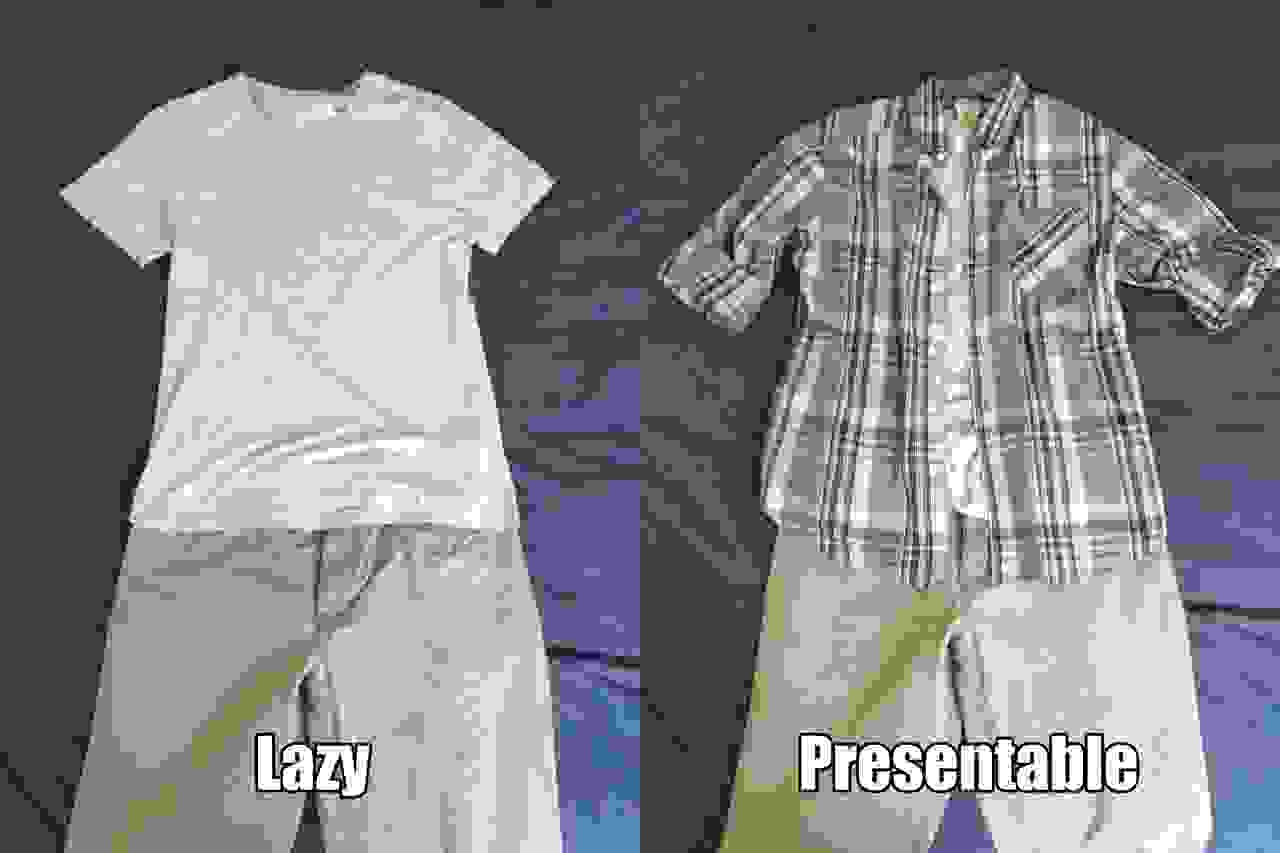Much has been written about the benefits of a minimalist lifestyle, and the reduced mental stress its simplicity can bring. Living only with possessions that see frequent use is a spectacular way to prevent unused clutter from accumulating in rarely-visited corners of unnecessarily large homes, thus preventing it from spreading like a horrific plague and devouring the house completely.

With the potential exception of a garage, the closet is probably the best place to look for possessions to cut from your life. It’s easy to find yourself with a gigantic wardrobe full of clothing you never wear, as some items may have been impulse purchases, or can only be used on special occasions; dress clothes that are only dress clothes are problematic, for example. Same goes for relaxing outfits that would be a humiliating embarrassment if ever worn in public. Thus:
Achieving a minimalist wardrobe, step by step
1) Be versatile
Beyond any other factor, the key to a minimalist wardrobe is versatility. If you can make use of the same items in a variety of situations, you won’t need massive quantities of specialized pieces that collapse off the shelves every time you open the closet.
The laziest way to achieve this is to keep everything semi-casual. Items that can be dressed up for fancy socializing (or dressed down for casual lounging) are far more useful than “special occasion” outfits that only get worn once or twice a year.
A good example is a pair of jeans, which can be classy or casual, depending on the rest of the outfit. Adding nice shoes and a button-up shirt can effortlessly convey the illusion that you have some semblance of sophistication and style, even if the truth remains embarrassingly otherwise.

This won’t work for everything, of course. You might still want business attire, workout gear, and other specialized outfits, which often can’t be used in any other setting. That’s fine, but unless you plan on wearing these on a regular basis, you can probably get away with owning just one or two outfits for each situation.
The silver bullet is still to find pieces that’ll work for everything (workout clothing can look just like ordinary clothing, except for designers being stupid and failing to do so), but admittedly it can be something of a challenge. Just keep the special-occasion-only outfits to a minimum, and you’ll be okay.
2) Everything goes with everything
People often assume that a minimalist wardrobe gets boringly repetitive. I would argue that if you only ever bother wearing half your clothing anyway, it’s probably not much better, and besides, if everything goes with everything else, you can get plenty of variety with a small number of items. 20 tops and 20 bottoms would mean 400 possible combinations, meaning you could wear a different outfit every day of the year, with plenty left over, and no repetition.
Of course you don’t need everything to work together, but the more you’re able to mix and match, the less you’ll need to accumulate. Items that clash with just about everything else should probably be replaced.
Luckily for me, I only enjoy dark and depressing shades of blue and grey, with occasional earth tones thrown in for fun. I can pretty much grab whatever I want and it’ll work out just fine, which is every bit as glorious as it sounds.

This doesn’t just apply to color. I had a jacket that had tight, high-friction sleeves, so it was difficult to wear anything underneath, and somehow it was still oddly bulky, so I couldn’t wear anything over it. It was nearly impossible to layer it with anything but a t-shirt, meaning I could only wear it under very specific weather conditions, rather than using it as a layering piece that could be combined with other items to work year-round. And thus…off to eBay it went. Which brings me to my next point:
3) Eliminate unnecessary pieces
Yes, it can be painful and horribly demoralizing. I don’t particularly know why, since it makes no sense to be emotionally attached to possessions you barely use, but such is the case.
A good trick I’ve seen is to flip all your hangers backwards, then flip them back when you use that particle article of clothing. A year later, throw out everything that’s still on a backwards hanger.
If you don’t have hangers, come up with an equivalent system. Shove all your clothes into a drawer, and move them elsewhere as you use them, or something like that.
A further step is to eliminate not only the items you barely use, but potentially redundant ones. Undershirts, pajamas, and bathrobes are good examples. It’s perfectly easy to live a long, healthy, happy life without them. Away they go.

4) Low maintenance is a basic human right
Remember sock garters? No? Good. That’s because they were stupid, and nobody bothers using them anymore. Same goes for suspenders. We’ve invented things that keep socks and pants from falling down so you don’t have to buy extra garbage to keep everything from collapsing all around you.
Sadly, the world has not yet embraced easy-care clothing to the exclusion of all other clothing. The world of button-up collared shirts remains an embarrassing, wrinkly cesspool of human imbecility, for which I have neither time nor sympathy. We must march in the streets with torches and pitchforks in numbers of historic proportions to set this injustice right.

In the meantime, try to find easy-care clothing that doesn’t require ironing or silly cleaning procedures. Though a variety of fabrics exist that would accomplish this, polyester is pretty much the only thing that’s widely implemented and readily available. Blending cotton with even just a little polyester eliminates the need for ironing, reduces drying time, and prevents shrinking. This is especially helpful when it comes to button-up shirts, but it can be useful elsewhere too. The less work you have to do, the more time you can spend doing important things, like watching funny cat videos on the internet.
5) Buy it for life
Remember how in the afore-mentioned Tyler Durden-related film, Brad Pitt says possessions don’t define you, and Edward Norton says he made sure to buy the right couch so he’d never have to buy a couch ever again? That was a damn good point! What the hell is the alternative? Buying a new one every few years?!!? Argh!
So of course you shouldn’t allow your possessions to define you, or hold you down in some way, but it’s worth taking some extra time to find something that you’ll enjoy for a decade, whether that refers to functionality or durability. And although I don’t pay much attention to the fashion world, I have been informed that classic styles don’t get marginalized as quickly as hip and trendy ones do.
I can’t say I’ve been wildly successful in this category, as I am a complaint-filled Goldilocks that can never be pleased, but it definitely feels nice when you find something that stays a favorite for years and years. You won’t always find a winner, but try to avoid impulse purchases by asking yourself if you plan to use it frequently. Buying only from places that have amazing return policies is helpful too.
Building a minimalist travel wardrobe
Wait, this is a travel blog, right? Right.
I have always advocated in favor of traveling with as little as possible while still having everything you might need to handle any and all situations that come your way. Minimalism isn’t necessarily about cutting corners; it’s about maximizing functionality with only minimal provisions. If you feel minimalism is holding you back, you may have gone too far.
I’ve always said the sweet spot is to bring enough clothing for a week, and do laundry once a week, which allows for some variety while still keeping laundry errands relatively rare. But the real advantage is that you’ll be able to travel with just a carry-on, allowing you to skip the luggage lines and baggage fees. You can certainly go lighter, particularly if you’re doing laundry in the sink, but I think this provides a good balance that practically anyone can accomplish, without going so minimal that you’ll go crazy.

I’ve written extensively on the specific items you’ll need for a minimalist travel setup, but the basic idea is to include maybe 5 or 6 tops and bottoms (maybe a few more in the summer), a nice shirt or two, a sweater, some ultralight winter gear if necessary, sandals, and just a single pair of shoes (though girls might want two, since society has more annoying rules for them). As long as everything is versatile enough to handle all sorts of social situations and climate fiascos, there isn’t much reason to carry much else, particularly if they all work together and look reasonably presentable.
What’s nice about a setup this versatile is that it makes a decent basis from which to build a real wardrobe, beyond simply being useful while traveling.
Other minimalist wardrobe essentials
One of the nice things about building a quality travel wardrobe is that if you do it correctly, you shouldn’t need much else. You should be covered for situations ranging from casual lounging to semi-classy evenings, and, depending on what kind of travel you enjoy, you should be able to handle some outdoorsy activities like swimming and hiking as well.
Aside from simply having more items in each category, all you’d really need in addition to this basic setup would be fringe-use outfits, like fancy business suits and help-friends-paint-a-wall rags. Maybe some workout gear too. But that’s about it. Building off a structure of well-crafted minimalism means you’ll only need a few specialty outfits for weddings or yoga practice or whatever.
Question yourself!
A major part of any project is developing the right frame of mind, and minimizing possessions is no different; you might find yourself shifting from merely wanting things to considering whether they’ll be useful or not. Whenever you’re about to buy something, clothing or otherwise, it helps to ask yourself a few questions like these:
- Will I be able to use it in a variety of situations?
- Will this integrate nicely with the rest of my belongings?
- Is it comfortable enough that I won’t get annoyed using it?
- Is it going to last for years?
- Do I have a similar item that already works just fine?
That last one is probably the biggest one…though I’m always happy to remind people that eBay is the world’s biggest garage sale. If you can replace something, rather than merely accumulate, then you’ll be fine.
I rather enjoy seeing people take this as far as it’ll go, from living out of a suitcase, or embracing the tiny house movement, or adhering to the 100 maximum possessions rule. It’s interesting to see how little people can live with, and how rarely they run into problems. Different people will find different levels to suit their individual needs, but I think you can go pretty far without much trouble, and slimming down the clothing collection is a good place to start.





I keep asking myself, “Is it worth packing something that I can buy cheap when I get there?”